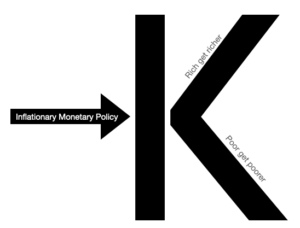With gas prices and virtually every other cost of living rising, responding to the declining dollar is something we all have probably thought about by now. One option available to us all is precious metals: namely gold, silver, and platinum.
The trick with getting metals into a retirement plan is in the Internal Revenue Code section that deals with collectibles. Strangely enough, it’s not in section 4975 (which deals with prohibited transactions); it’s in 408 which deals with IRAs. Even more odd is the fact that one part of this section is applicable to self directed qualified plans (like a Solo 401k) with no reference to its applicability within the code sections for qualified plans. This is why tax attorneys have work to do.
In 408(m)(2), they prohibit investment into collectibles and further define collectibles to include any metals or coins. 408(m)(3) goes on to exclude certain coins and bullion from being defined as “collectibles” for the purposes of disallowed investments. It breaks these “certain coins and bullion” down into two categories. (A) is essentially American Eagle coins minted by the United States. (B) is bullion that that meets or exceeds the fineness required by regulated futures contracts if such bullion is in possession of a custodial account at a bank or trust company.
So when it comes to Self Directed IRAs and Solo 401(k)s, it appears that American Eagle coins are allowable for both types of plans. Further, a retirement plan can (through a custodian as trustee) own certain bullion, but cannot do so with checkbook control plans (an IRA LLC or a Solo 401k that is self administered and self trusteed). This appears to offer a benefit to having your transactions handled by a custodian because doing so would allow for ownership of certain bullion (in case you’re lost, bullion is simply unminted metal of a certain purity – such as a 99.9% pure bar of gold). I would suggest that holding gold bullion at a custodian is not a good idea.
Why are you holding gold in the first place? The top reasons are usually:
- To store value while the dollar declines
- To store value while the economy and government are dealing with troubles
- To enjoy increased value due to an increased demand for tangible, uninflatable assets
Right now, it is undeniable that the dollar has been declining and as a general trend will continually decline as long as it is a fiat currency. Most people would further agree that the economy, banking system, and government, in general, is currently in trouble – evidenced by:
- unusually low interest rates
- insolvency of subprime lenders
- mutual fund overexposure to subprime lending
- insolvency of investment banking giant Bear Stearns
- corporate scandals (Enron, WorldCom, etc)
- increasing unemployment
- the fact that goods and services are being created and rendered in China & India at an alarming rate
This situation as a whole is what makes precious metal ownership enticing. Historically, governments, economies, markets, and empires rise and fall. But since the beginning of time, gold has been valuable… always. There’s not too much “always” in our current situation anymore. There’s no more “real estate always goes up every year”. There’s no “the stock market always appreciates at 9% on average” when you look at its current volatility and look beyond a few decades of history. “Gold has always been valuable” is the only always we have left. So uncertain times cause us to revisit that fact.
We’re still talking about “it’s probably not good to own bullion at a custodian” remember? Stay with me; I promise we’re getting there. If you’ve read arguments for or against gold ownership, you’ve probably encountered the threat of confiscation. On April 5th, 1933 President Roosevelt ordered all U.S. persons to surrender all gold coins, gold bullion, and gold certificates to the Federal Reserve. Many historical accounts lead us to believe that everyone just lined up and turned in their gold.
The Collapse of the Dollar by James Turk & John Rubino suggests otherwise. Their data says that gold in circulation was declining for the few years preceding the 1933 confiscation because people anticipated the governmental confiscation and started hiding their gold because of it. The confiscation resulted in about 22% of the gold in circulation being turned in. The government claimed the rest of the gold coins were lost or destroyed – let’s be serious! Apparently, by January 1934 the missing coins were all back in circulation.
In light of the actual happenings in the gold confiscation of April 1933, there has never been an effective confiscation. If history repeats itself, would you prefer to be a person who has surrendered their wealth or who has protected it? If you’d like to protect it, you can’t do so owning bullion in a IRA custodian account. Placing bullion in the hands of a custodian (a bank or trust company) effectively surrenders it from the start in the case of future government confiscation.
If you need one more reason not to let IRC 408(m)(3)(B) bother you, it’s that ownership of minted coins is more liquid anyways. When it comes time to sell a coin, a U.S. minted American Eagle is immediately identified for its reliable purity. A gold buyer will likely not require testing of the actual coins. With bullion, that reliance on purity is not always there. The premium you pay for a minted coin is so nominal, that the extra ease in selling is surely worth it.
More precious metal food for thought is that I encourage you to also consider silver. Firstly, there has never even been an attempt by the U.S. government to confiscate silver. Secondly, the “buzz” is about gold, and much of the inflation hedging has been manifested by gold acquisition. So, the buzz has probably run the price of gold up more than the price of silver. As a third point, consider that silver has many industrial uses. It is used as a component in most electronics, and the flattening of the world (as observed by Friedman) is quite rapidly bringing cell phones and computers to billions of workers in India & China – all requiring silver in the manufacturing process.
I recently took a look at a checking account of mine that has had $15,000 in it since December of 2006. A year of that sitting there made me $6.59 in interest from Bank of America. More importantly, I did a basic calculation that told me that my $15,000 was now worth $13,122. Had I invested that $15,000 into gold during the same time period, it would be worth about $19,707 inflation adjusted. Because I was invested in U.S. currency I experienced a 12.5% loss while gold experienced a 31.4% gain. Hindsight is 20/20 and we can all become billionaires investing in the past, but in all seriousness, there was no denying that the uncontrollable floating value of the dollar was hurting me. The minute I realized what was happening to my money, I invested $6,000 into an equal split of gold, silver, and platinum. I’m receiving 0 dividends, and I don’t check the prices every day, but I have something of value. It’s probably not going to get me rich, but I’m positive these physical objects will always have value. And maybe Chindia will run up the price of my 100 ounces of silver.


